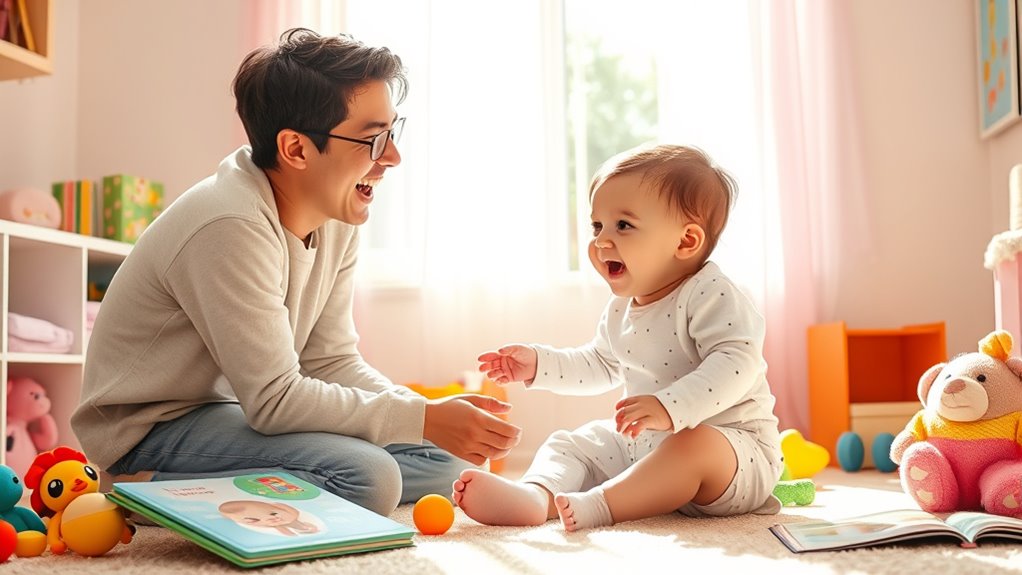To encourage your baby’s talking, interact with them often by responding to their sounds and gestures. Use simple, descriptive words while narrating your daily activities, and keep a language-rich environment through singing and reading. Maintain eye contact and use a warm tone to engage them emotionally. Don’t forget to celebrate their attempts at communication! If you keep these tips in mind, you’ll be setting the stage for exciting language development ahead.
Key Takeaways
- Talk frequently to your baby during awake times, using simple words to describe objects and activities.
- Respond to your baby’s coos and babbles, encouraging them to communicate more.
- Use “parentese”—a singsong, exaggerated voice—to engage your baby and make interactions more captivating.
- Read together daily to introduce new vocabulary and concepts in a fun way.
- Sing nursery rhymes and engage in playful interactions to foster imitation and exploration of sounds.

Encouraging your baby’s talking can be an exciting journey, and it’s crucial to start early. Around six to nine months, you’ll notice your little one entering the babbling stage, producing sounds like “ba-ba” and “ma-ma.” This is a vital part of their speech development, where crying and babbling serve as early communication methods. Your baby learns by listening to you, so your interactions are essential in shaping their language skills.
Creating a language-rich environment will significantly boost your baby’s talking abilities. Talk to them frequently, especially when they’re awake. Describe objects around them using simple, descriptive words like “soft” or “blue.” This not only expands their vocabulary but also helps them connect words with meanings.
Creating a rich language environment is key; talk often, describe objects, and expand your baby’s vocabulary with simple words.
Singing and dancing together can also promote language development through the rhythm and melody of sounds. When your baby babbles, don’t hesitate to babble back. This back-and-forth interaction encourages them to continue communicating. Reading together daily fosters a soothing atmosphere filled with new words and concepts.
Responding to your baby’s attempts at communication is crucial. Imitate their sounds and gestures to teach them the art of turn-taking and conversational flow. Maintain eye contact during your conversations; it shows them you’re engaged and interested. Smiling and using a warm tone will help them understand different emotions and tones in speech.
Try using “parentese,” which involves elongated vowels and exaggerated tones, to make your speech more engaging. Always respond to their cues, as this responsiveness is vital for their language growth.
Watch for age-appropriate milestones in your baby’s speech development. From birth to three months, they’ll recognize voices and coo in response. By four to six months, expect laughter and playful sounds as they explore new noises. Between seven and eleven months, they’ll start babbling and responding to their names.
Once they reach twelve to eighteen months, you can anticipate their first words and the beginning of sound combinations. By age two, they’ll likely use two-word phrases and have a vocabulary of around fifty words.
To encourage those first words, narrate daily activities, pointing out objects and naming them correctly. Singing nursery rhymes can be a fun way to associate movement with words. Engaging in playful interactions promotes imitation and learning.
Frequently Asked Questions
At What Age Do Babies Typically Start Babbling?
Babies typically start babbling around 4 months old. You’ll hear them combining consonant and vowel sounds like “pa” or “ba.”
By 6 months, they often string vowels together and add more consonants. Keep in mind that some babies might begin babbling closer to 6 months.
As they approach 9 months, you’ll notice a wider variety of sounds, paving the way for their first words by around 12 months.
Enjoy this exciting stage of development!
How Can I Tell if My Baby Is Hearing Properly?
Checking your baby’s hearing is like tuning a musical instrument; you want everything to sound just right.
Start by observing their reactions to loud noises; notice if they startle or calm to familiar voices. By 4 to 6 months, they should follow sounds with their eyes and respond to tone changes.
If you suspect any issues, schedule a hearing screening to ensure their auditory development is on track. Early detection is key!
What if My Baby Isn’t Making Sounds?
If your baby isn’t making sounds, it’s important to stay calm but attentive.
Observe their behavior and consider factors like hearing ability and interaction levels. Engaging them in playful activities, like singing or talking, can stimulate sound-making.
If you notice no vocalizations by 9 months, consulting a pediatrician might be wise. They can assess any underlying issues and guide you on supporting your baby’s communication development effectively.
Are There Specific Toys That Promote Talking?
Yes, there are specific toys that promote talking.
Consider using toy cars and trains to model sounds like “vroom” and “choo choo” during play. Baby dolls encourage you to engage in pretend scenarios, discussing feelings and actions.
Animal farm sets help teach sounds, while kitchen sets introduce new vocabulary. Interactive books invite storytelling and verbal routines, making playtime language-rich and fun for both you and your little one.
How Do Different Languages Affect Baby’s Speech Development?
So, you think throwing a bunch of languages at your baby will magically turn them into a little polyglot? Well, it might!
Babies are language sponges, soaking up sounds and rhythms. Bilingual babies can distinguish between languages, which can actually boost their cognitive skills.
They might mix words at first, but that’s just their brain’s way of flexing its muscles. Give them a rich linguistic environment, and watch their speech flourish!
Conclusion
Encouraging your baby to talk is a delightful dance between silence and sound. While you patiently wait for their first words, cherish the coos and babbles that fill the air. Each little noise is a step toward conversation, revealing their curiosity and personality. As you nurture their language skills, remember that the quiet moments of connection are just as important as the joyful exchanges of chatter. Embrace both, and watch your baby’s world come alive with language.









